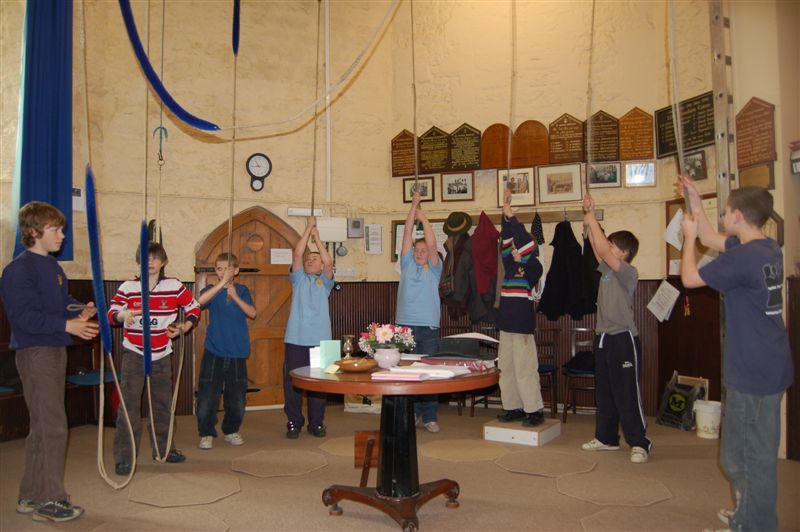Plain Hunt
Plain Hunting is really simple, BUT explaining how to do it is difficult. It is so easy that once you can do it you wonder why it took you so long! One of the problems is that different people find the bells to follow in different ways. So experienced ringers try to explain it to you, and you get all the different ways of doing it mixed up and confused. I think that more people give up ringing at the learning to hunt stage than at any other time.

So... don't be put off. Read everything you can get your hands on, listen to what people are telling you, and, best of all, have lots of goes at it. Of course, that isn't easy, as you probably only get a couple of chances to try it on a practice night. What you really need is a special practice just for you and perhaps one or two friends. An hour and a half on some light bells, with the learners taking it in turns to ring, while the others watch, is a real help. You need six good ringers to come and help you - five to ring with you and one to stand behind you. We organise these and call them "Masterclasses"! Unless you live in South Somerset, you will have to talk nicely to the experienced ringers in your tower and see if they will oblige.
Before you try Plain Hunting, you must be able to control your bell. You need to be able to ring faster and slower at a moment's notice. To ring faster you actually need to LOWER your bell a tiny little bit. To ring slower you have to pull a bit harder so that the bell doesn't actually touch the stay, but it is right up near it at each stroke. So if you can, learn to raise and lower a bell before you attempt Plain Hunting. (Not necessarily in peal, on your own is fine.) Don't be afraid to ask for extra practices to be arranged - your instructor will most likely be pleased that you are showing an interest.
You probably will have seen ringing methods set out on paper. They are lots of rows of numbers, and the numbers will be joined up with coloured lines. Usually the Treble's line is red, and the rest are blue. And it all looks double dutch to you!
A bell that is Plain Hunting rings one blow in each "Place" until it reaches "The Front" or "The Back".
Place:
If you are ringing Rounds, the treble is leading, the 2 is ringing in "2nd's place", the 3 is ringing in "3rd's place, the 4 is in "4th's place, and so on. If someone calls "2 to 3", then the bells ring in the order 132456. Here the Treble is still leading, the 3 is in the 2nd's place, and the 2 has moved to the 3rd's place.
A Change:
A "Change" or a "Row" is when each bells sounds once in one place and then again in another place. So 12345, 21435, 24153 is three changes or rows.
Front:
If you are "at the front" you are leading.
Back:
If you are "at the back" you are ringing last in a change.
Plain Hunting on 5 bells , with the Tenor ringing last
When the Conductor shout's "Go, Plain Hunt", it should be at the Treble's Handstroke. Everyone completes that Handstroke and the next Backstroke, and then the fun begins.
We'll just look at the Treble's work for a moment. The Treble rings his next Handstroke in 2nd's place, his next Backstroke in 3rd's place, a Handstroke in 4th's place and a Backstoke in 5th's place (or last in the queue, apart from the Tenor who is remaining behind all the others all of the time.)
Having arrived "at the back", the Treble rings another blow "in 5th's place" (so that is two blows at the back), then a Backstroke in 4th's, a Handstroke in 3rd's and Backstroke in 2nd's place, and then he leads for a Handstroke and a Backstroke. That's all there is to it!
Follow the pattern that the Treble makes and you will see that it is a straight line, which turns around when it gets to the back and comes straight back in again.
123456
214356
241536
425136
452316
543216
534126
351426
315246
132546
123456
Every other working bell does the same shaped line, but they all start at different points along it. So the 2nd starts by leading for a Handstroke and Backstoke before he rings a straight line up to the back and down to front again. The 3rd starts part way through the straight line up to the back, and so on.
Try to find some squared paper and draw out the lines for each bell in different colours. It looks just like plaiting!
Well, that's all very well, but how on earth does it work in practice? Everyone nags at you about not learning the numbers of the bells to follow, but no one explains how to FIND which bells to follow. In fact, learning the numbers can work, but I suspect that it's only very good mathematicians that ring this way. It's quite right that learning the numbers parrot fashion will not get you very far at all. But learning how to USE the numbers is absolutely fine. The links below will take you to articles by different people, explaining various ways of finding the bells. We hope you will find something here that helps you to "see the light". Of course nothing will be a substitute for lots of practical experience, but keep coming back to these articles in between ringing practices, and eventually you will be able to Plain Hunt without any effort at all.
